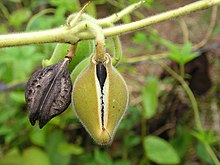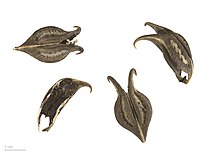Annual Martynie
| Annual Martynie | ||||||||||||
|---|---|---|---|---|---|---|---|---|---|---|---|---|

Annual Martynia, flowering |
||||||||||||
| Systematics | ||||||||||||
|
||||||||||||
| Scientific name of the genus | ||||||||||||
| Martynia | ||||||||||||
| L. | ||||||||||||
| Scientific name of the species | ||||||||||||
| Martynia annua | ||||||||||||
| L. |
The annual Martynia ( Martynia annua ), also cat's claw and devil's claw , is the only plant species of the monotypical genus Martynia in the family of chamois horns ( Martyniaceae ). It comes from the New World and can now be found worldwide as a neophyte in tropical countries .
description
Habitus
Long- lasting summer annuals that arise from thick beet roots and grow up to 1 m high or higher. The fleshy, greenish shoots lignify easily with age.
Vegetative characteristics
The leaves appear on stems up to 25 cm long. The egg-shaped, triangular to heart-shaped leaf blades are up to 25 cm long and up to 30 cm wide. The leaf base is heart-shaped to blunt. The leaf margins are slightly lobed to distantly serrated or finely serrated. The end of the leaf is pointed to rounded. The leaves and stems, but also the flowers and flower stalks, are hairy and sticky.
The species or genus can be described as precarnivorous .
Generative characteristics
The narrow, bell-shaped and five-fold flowers appear numerous (up to 20) per inflorescence in loose clusters, the inflorescence becomes as long as the leaves. There are bracts available. The stalked flowers are 4–6 cm long and have an unpleasant smell. The bracts are oblanceolate and sloping. The sepals are free-standing and also lanceolate. The corolla, which is hairy on the outside, is white to pale pink and has two lips. The narrowed part of the flowers towers above the sepals , the tube itself is bulbous to obliquely bell-shaped. The throat is decorated with yellow, orange or purple spots and streaky sap marks . The petals are more or less far and each have a purple spot. The flowers each have two stamens and three staminodes , the anthers are up to 8 mm long. The ovary is upper constant with thread-like stylus with a two-lobed stigma . There are only a few ovules . The flowering period begins in June and lasts until November , with the peak in August .
The short -beaked and fine-haired, brownish to greenish-yellow fruits when ripe are egg-shaped to elliptical and depressed on their backs like on the stomach, the meso- and exocarp is sloping, the dark brown and woody-ribbed and sculpted endocarp is 25-40 mm long and light split. The short horns of the capsule are about 1 cm long. Per capsule 2–4 seeds up to 2 cm long with a paper-like shell are formed.
The number of chromosomes is 2n = 32 or 36.
distribution
Martynia annua is originally from Mexico and Central America , it is particularly widespread in Belize , Costa Rica , El Salvador , Guatemala , Honduras and Nicaragua . It is also found in the West Indies , such as Cuba , Puerto Rico , Jamaica and the Dominican Republic . Neighboring islands are also part of their natural home. The species has now been naturalized in tropical regions of the Old World , such as Ghana , India , Sri Lanka and Thailand . But it is also a neophyte in Australia and New Caledonia , as well as in Pakistan and Nigeria .
Systematics
The genus is named after the German-English botanist John Martyn (Johannes Martyn, 1699–1768).
There is only one type:
- Martynia annua L .; Annual Martynie, Cat's Claw, Devil's Claw, Uña de gato, Uña del diabolo, Uña de gavilan, Sobrerete, Toritos, Aguaro; Syn. Martynia angulosa Lam. , Martynia diandra Gloxin , Carpoceras longiflora A.Rich. , Disteira angulosa Raf. , Vatkea diandra O. Hoffm .
use
Martynia annua , as it were other genera from the Martynia family, has been cultivated in Europe since the 17th century . Its pretty flowers made it popular as an ornamental plant and so it quickly spread over various regions of the world, where it escaped the local garden cultures and has now become part of the local flora as a neophyte. In Mexico , their dried fruits are made into trailers. In addition, the dried fruits are burned there and in Central America and their ashes are used to treat paralysis. The sticky leaves serve as lice catchers in local beds , but they are also said to be edible and are used medicinally, like the fruits and seed oil. The seeds and fruits are also edible.
literature
- Raul Gutierrez: A Phylogenetic Study of the Plant Family Martyniaceae (Order Lamiales). Dissertation, Arizona State Univ., December 2011, online (PDF; 41.7 MB), at ASU Digital Repository.
- Joachim W. Kadereit: Flowering Plants Dicotyledons: Lamiales (except Acanthaceae including Avicenniaceae) (= The Families and Genera of Vascular Plants , Volume 7). Springer, Berlin / New York City 2004, ISBN 978-3540-40593-1 .
Web links
- Martynia annua on keyserver.lucidcentral.org, accessed October 3, 2018.
Individual evidence
- ^ A b c d e Raul Gutierrez: A Phylogenetic Study of the Plant Family Martyniaceae (Order Lamiales). Pp. 106-108, 127 f.
- ↑ a b c Joachim W. Kadereit: Flowering Plants Dicotyledons. Pp. 283, 287, 288.
- ↑ a b c d A. Dhingra, Ashwani, B. Chopra, Bhawna, SK Mittal: Martynia annua L .: A Review on Its Ethnobotany, Phytochemical and Pharmacological Profile. In: Journal of Pharmacognosy and Phytochemistry. 1 (6), 2013, 135-140, online at researchgate.net, accessed October 3, 2018.
- ↑ Martynia annua at Australian Tropical Rainforest Plants, accessed October 3, 2018
- ^ Maarten JM Christenhusz, Michael F. Fay, Mark W. Chase: Plants of the World. University of Chicago Press, 2017, ISBN 978-0-226-52292-0 , p. 561.
- ↑ Martynia annua in the Flora of China, Vol. 18.
- ^ Raul Gutierrez: A Phylogenetic Study of the Plant Family Martyniaceae (Order Lamiales). P. 109.
- ↑ Helmut Genaust: Etymological dictionary of botanical plant names. Birkhäuser, Basel / Stuttgart 1976, ISBN 3-7643-0755-2 .
- ↑ Lotte Burkhardt: Directory of eponymous plant names . Extended Edition. Botanic Garden and Botanical Museum Berlin, Free University Berlin Berlin 2018. [1]
- ^ Raul Gutierrez: A Phylogenetic Study of the Plant Family Martyniaceae (Order Lamiales). P. 12 f.
- ↑ Devil's Claws: Hitchhikers On Big Animals at Palomar College, accessed October 3, 2018.
- ^ Carla Emery: The Encyclopedia of Country Living. Sasquatch Books, 2012, ISBN 978-1-57061-841-3 .


